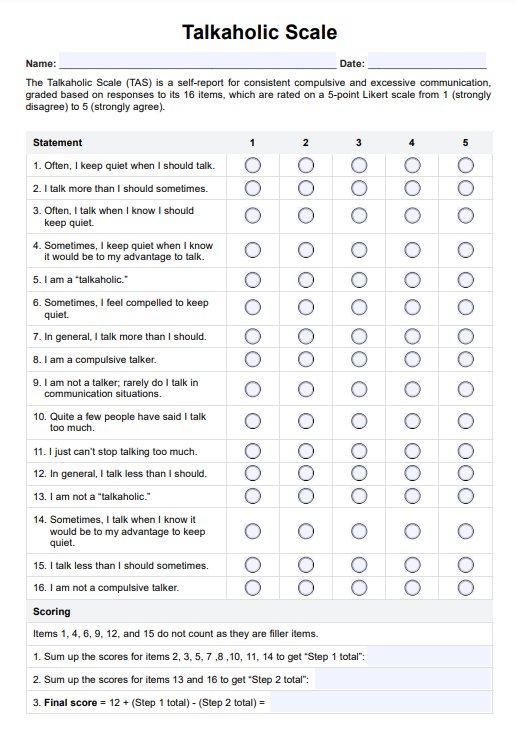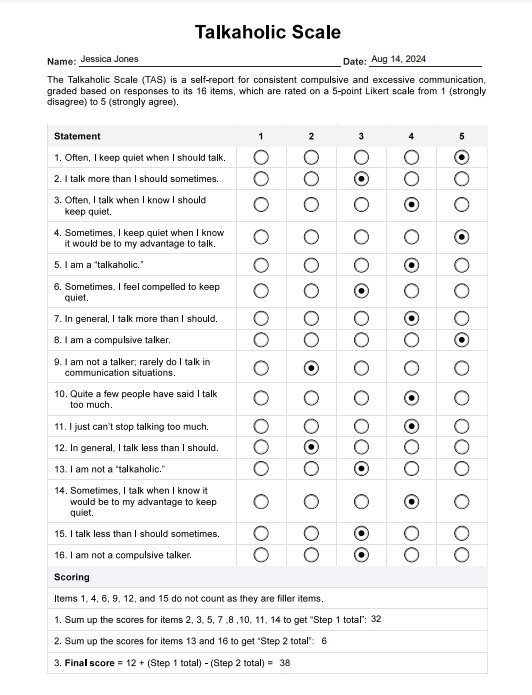Talkaholic Scale
Identify compulsive talking with the Talkaholic Scale, a self-report tool designed to measure excessive communication tendencies. Learn more today.


What is the Talkaholic Scale?
Talkaholism refers to compulsive and excessive talking, where an individual feels a constant urge to speak, often at the expense of listening or considering social cues. People with talkaholism may dominate conversations, interrupt others frequently, and struggle to stay quiet even when it would be appropriate to do so. This behavior can strain relationships, create social awkwardness, and lead to challenges in professional and personal environments.
For unaware talkaholics, it may feel normal to speak at length without pausing, making it difficult to recognize the issue. Often, it’s not until others point it out or the consequences become apparent that individuals realize the extent of their behavior. This is where the Talkaholic Scale comes in.
The Talkaholic Scale (TAS) was developed by communication research scholars James C. McCroskey and Virginia P. Richmond as a way to identify and quantify talkaholism. This self-report tool consists of 16 items, each rated on a 5-point Likert scale from "strongly disagree" to "strongly agree." The scale measures different aspects of compulsive talking, such as the inability to remain silent, the frequency of dominating conversations, and the awareness of others' reactions to excessive talking (McCroskey & Richmond, 1993; McCroskey & Richmond, 2009).
The results help clinicians and communication researchers assess the severity of talkaholism and guide interventions to manage this behavior. Identifying talkaholism early through the Talkaholic Scale can help prevent its long-term effects, such as social isolation, damaged relationships, and professional setbacks.
Talkaholic Scale Template
Talkaholic Scale Example
How to use our Talkaholic Scale template?
To effectively use our Talkaholic Scale template, follow these steps:
Step 1: Access the template
Access the Talkaholic Scale template by clicking "Use template," which will open it in the Carepatron app. This will allow you to either customize it, fill it out digitally, or print it for physical use. Ensure that the template is readily available before meeting with your patient, or you can just send it to them via the app. You can also save a non-customizable but fillable and printable PDF copy by clicking "Download".
Step 2: Have the patient complete the scale
Administer the scale to a patient who you believe may exhibit symptoms of talkaholism. Provide clear instructions on how to complete the scale, emphasizing that the patient should answer each item honestly based on their recent behavior and communication habits. Explain that the purpose of the scale is to gain insights into their communication patterns.
Step 3: Complete the scale
Because this scale is a self-report, you can either wait for the patient to complete it on their own or go through the items together with them. If done together, this allows for immediate clarification of any uncertainties and ensures the patient understands each question. Once the scale is completed, move on to tally the results using the method indicated in the template. We'll also go over that in this guide in a later section.
Step 4: Discuss the results with the patient
Once the results have been tallied, be prepared to discuss the findings with the patient. If they approach you with their results, review the scores together and help them understand what their score indicates about their communication habits. This discussion can also be an opportunity to explore any concerns the patient might have and to plan possible next steps based on the findings.
Scoring and interpretation
The Talkaholic Scale is scored by evaluating the patient’s responses to specific items on the scale. The calculation is not as straightforward as other scales.
To determine the final score, first, sum the scores for items 2, 3, 5, 7, 8, 10, 11, and 14. This total represents the patient's tendencies toward compulsive communication. Then, sum the scores for items 13 and 16, which indicate the patient’s self-awareness regarding their communication behavior. Finally, calculate the final score using the following formula:
Final score = 12 + (Step 1 total score) — (Step 2 total score)
The resulting score will fall between 10 and 50, and is interpreted as follows:
- Normal: A score below 30 suggests a normal ability to control communication without compulsive tendencies. Most people score in this range.
- Borderline Talkaholic: A score between 30 and 39 indicates that the patient often struggles to remain quiet in communication situations when it would be advantageous, though they still have some control over their talking.
- Talkaholic: A score above 40 signifies that the patient’s communication is consistently compulsive, which may lead to challenges in social or professional interactions.
These interpretations provide insight into the severity of the patient’s communication habits and can guide appropriate interventions.
Next steps after using the scale
Once the Talkaholic Scale has been completed and scored, consider the following next steps:
- Discuss the results: Review the patient's score and interpretation with them. Explain what their score suggests about their communication habits, whether they fall into the normal, borderline talkaholic, or talkaholic category.
- Provide individual therapy: If the patient scores as a talkaholic, consider recommending individual therapy. This therapy can focus on cognitive-behavioral techniques to help the patient develop better communication control, learn active listening, and address any underlying issues contributing to their compulsive talking.
- Suggest group therapy: Group therapy can be an effective way for patients to observe and learn from others with similar issues. It also provides a controlled environment for the patient to practice and refine their communication skills.
- Encourage self-awareness exercises: Recommend activities that promote self-awareness, such as journaling or mindfulness exercises. These can help patients recognize when their talking becomes excessive and develop strategies to manage it.
These steps provide a comprehensive approach to managing and treating compulsive communication tendencies, ensuring the patient receives the support they need to improve their communication habits.
Reference
McCroskey, J. C., & Richmond, V. P. (1993). Identifying compulsive communicators: The Talkaholic Scale. Communication Research Reports, 10(2), 107–114. https://doi.org/10.1080/08824099309359924
McCroskey, J. C., & Richmond, V. P. (1995). Correlates of compulsive communication: Quantitative and qualitative characteristics. Communication Quarterly, 43(1), 39–52. https://doi.org/10.1080/01463379509369954
Commonly asked questions
Compulsive talking is often referred to as talkaholism or compulsive communication, when a person talks excessively because they feel compelled by an uncontrollable urge to do so.
The Talkaholic Scale (TAS) is a tool for identifying compulsive communicators. Higher scores indicate a greater tendency towards excessive communication.
Dealing with a talkaholic may involve setting boundaries, encouraging self-awareness, and suggesting professional help such as therapy to manage their communication habits.
You may be talking too much if others frequently comment on your talking habits, or if you find it difficult to stop talking even when you know you should. Taking the Talkaholic Scale can help you assess your communication habits and see if you are a compulsive talker.





















-template.jpg)


















































































